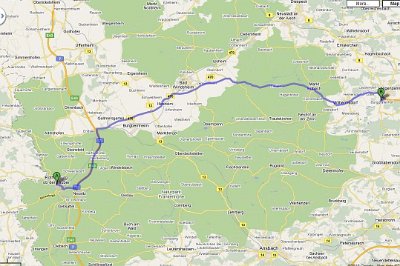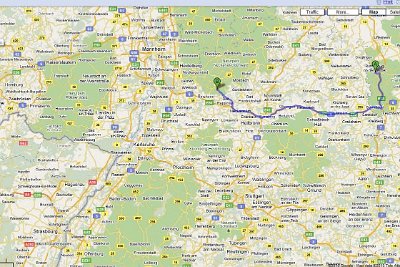 1 Tuesday 13 July, 2010 After dessert at Wolfram and Gisela's, we drove 60 kms to Rothenburg ob der Tauber in the Franconia region of Bavaria. Our purpose was to visit the beautiful mediaeval village of Rothenburg. |
 2 Tuesday 13 July, 2010 As we entered the village, we could see that the top of Rothenburg's city wall had been reconstructed after being bombed during WWII. The original stones are blackened from the bombing. |
 3 Tuesday 13 July, 2010 Rothenburg has appeared in several films, mainly fantasies. It was the inspiration for the village in the 1940 Walt Disney movie Pinocchio. |
 4 Tuesday 13 July, 2010 In the Japanese anime film series "A little snow fairy sugar", the main character lives in Rothenburg. This series has made Rothenburg a popular destination for Japanese tourists. Many of the shops had dual language Japanese and German signs outside their doors and, at the time, I wondered why this was so. |
 5 Tuesday 13 July, 2010 Rothenburg had special significance for Nazi ideologists because it epitomised the German 'Home Town' and represented all that was quintessentially German. At least they got that bit right. |
 6 Tuesday 13 July, 2010 In March 1945 near the end of World War II, German soldiers were stationed in Rothenburg to defend it. On March 31, sixteen planes dropped bombs on Rothenburg killing 39 people that destroyed 306 houses, six public buildings, nine watchtowers and over 610 meters of the wall. |
 7 Tuesday 13 July, 2010 The US Assistant Secretary of War was aware of the historic importance and beauty of Rothenburg, so he ordered US Army General Jacob Devers not use artillery in taking Rothenburg. |
 8 Tuesday 13 July, 2010 On the German side, military commander Major Thömmes ignored Hitler's order for all towns to fight to the end and gave up the town, thereby saving it from destruction. American troops occupied the town on April 17, 2½ weeks after the bombing. |
 9 Tuesday 13 July, 2010 After the war, the city's residents quickly repaired the bombing damage with donations for the rebuilding coming from all over the world. The rebuilt walls feature commemorative bricks with donor names. |
 10 Tuesday 13 July, 2010 At the top of the marktplatz is the City Councillors' Tavern (1446). The main clock was installed in 1683 and beginning in 1910, the two windows located to the right and left of the clock open every hour between 11.00a.m. and 03.00p.m. and between 08.00p.m. and 10.00p.m. to show the legendary "Master Draught" (der Meistertrunk) . . . |
 11 Tuesday 13 July, 2010 . . . this legend goes back to the year 1631 in the midst of the Thirty Years War when Catholic troops attacked and occupied Protestant Rothenburg. The Catholic general, Tilly, threatened to plunder and destroy the city. On a whim he promised to spare the town from destruction if a Councillor could manage to empty an enormous tankard containing 3¼ litres of wine in one draught. The mayor accomplished this task and by doing so saved his city. Rothenburg celebrates this event each year on Whitsun with a festival performance, grand army march and a field camp. |
 12 Tuesday 13 July, 2010 The rear Gothic part of the Rathaus dates from 1250 and the front Renaissance building was started in 1572. The building served as the seat of government for the city-state during medieval times and now serves as the town hall for the city of Rothenburg. |
 13 Tuesday 13 July, 2010 The marktplatz looking back down the hill from the Rathaus. We've just been to the toilet located behind us for an absolutely wonderful pee. |
 14 Tuesday 13 July, 2010 The name "Rothenburg ob der Tauber" means "Rothenburg above the Tauber" because the town overlooks the Tauber river. |
 15 Tuesday 13 July, 2010 As to the name "Rothenburg", some say it comes from the German words Rot (Red) referring to the red-coloured roofs of the houses that overlook the river, and Burg (medieval fortified town). |
 16 Tuesday 13 July, 2010 The "Jagstheimer House", now occupied by the Marien apotheke, was built in 1488 for Mayor Jagstheimer. The house has a decorative half-timbered gable with a picturesque oriel (the bit sticking out) and a scenic courtyard containing richly ornamented gallery balustrades. It is located next to the Meat and Dance house on the southern end of the market square. |
 17 Tuesday 13 July, 2010 Claus, Jenni and I have a mutual friend named Ted who lives in San Francisco. We all thought about him when we saw Teddyland. |
 18 Tuesday 13 July, 2010 In the background is the Church of St. Jacob, the largest church in the city. It is a Lutheran church with two towers (south tower 55.2 m, 57.7 m north tower) and was built between 1311-1484. |
 19 Tuesday 13 July, 2010 This is another entrance to the town. |
 20 Tuesday 13 July, 2010 The old city walls have been restored after being bombed in WWII. I can imagine during medieval times repelling invaders with buckets of boiling oil dispatched from the top of the wall. |
 21 Tuesday 13 July, 2010 This was a great choice that Claus made. It is a beautiful town with an interesting history, stories and legends surrounding it. In its time, Rothenburg has had its savage periods while mostly it was a centre for the arts & crafts and culture. Real people have always lived here - they were never cast members in a glorified Disneyland. |
 22 Tuesday 13 July, 2010 We leave Rothenburg and travel 130 kms to Neckarbischofsheim to stay overnight in a small Gasthof. We're north of Stuttgart and not that far from Strasbourg. |
 23 Tuesday 13 July, 2010 Our gasthof for the night in Neckarbischofsheim. Our room was on the first floor on the right facing the street. Claus chose this place because it is very near tomorrow's first adventure at Sinsheim. |
 24 Tuesday 13 July, 2010 The owner had a very interesting wine cellar downstairs that he showed to Jenni and Claus. Next stop: Sinsheim |